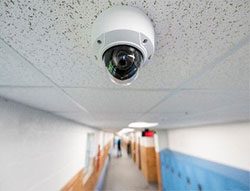 The District is in the process of replacing its legacy analog surveillance system in schools with a contemporary IP based enterprise level surveillance system with advanced capabilities that will take the school safety to a new height. The current legacy system is based on an older analog coaxial cable-based technology that is managed at the school level without any advanced features, enterprise oversight, or access beyond the school building. The current system suffers from various issues including the inability to detect and address camera outages, cumbersome retrieval of videos pertaining to incidents due to local camera recording in schools, inability to add cameras with ease due to the need for power and coax cabling, difficulty in granting camera access to others such as principals, difficulty collaborating with law enforcement, and lack of any advanced features.
The District is in the process of replacing its legacy analog surveillance system in schools with a contemporary IP based enterprise level surveillance system with advanced capabilities that will take the school safety to a new height. The current legacy system is based on an older analog coaxial cable-based technology that is managed at the school level without any advanced features, enterprise oversight, or access beyond the school building. The current system suffers from various issues including the inability to detect and address camera outages, cumbersome retrieval of videos pertaining to incidents due to local camera recording in schools, inability to add cameras with ease due to the need for power and coax cabling, difficulty in granting camera access to others such as principals, difficulty collaborating with law enforcement, and lack of any advanced features.
The new IP based surveillance system will not only address the shortcomings of the existing legacy system referenced above, but it will also offer contemporary features that will address the safety needs and concerns of NBOE schools for the years to come. The new system will be a centralized system that will be integrated with the District’s IP network and will incorporate centralized recording and retrieval of video footage on servers, and provide board access to the system from anywhere using multiple platforms including mobile phones, local and district level monitoring of cameras. Additionally, the system will supply live dashboards for ease of monitoring including a dashboard for offline cameras, automatic alerts for triggered events such as after hour suspicious activities, higher resolution cameras with night vision capability, ability to program cameras to detect specific objects such as vehicles, advanced video search and analytics. Furthermore, this initiative will also expand the number of cameras in NBOE schools from the current base of 2,200 analog cameras to 7,200 IP cameras, which will allow the District to provide surveillance coverage to critical areas of the schools that currently lack coverage.